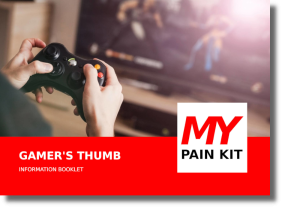Test To See If Thumb Pain Is Gamer's Thumb (Video)
A 10-Second Test For Gamer’s Thumb
This is also known as “Finkelstein’s Test”:
The Risk Of A Gamer Lifestyle
How many hours a week do you spend gaming? If it’s more than 10, you are at high risk of developing a painful condition called Gamer’s Thumb.
People who are typically at risk are:
- Recreational gamers who play for over 10 hours a week
- Professional eSports Athletes (duh!)
- Streamers and people who socially game online
The third group are particularly interesting, because we are seeing a NEW influx of people into our clinics, with this problem.
Even if you’re a fairly average gamer, if you are experiencing Thumb Pain – here is a quick 10-second test to see if you might have developed Gamer’s Thumb
Does Gamer’s Thumb Pain Go Away On It’s Own?
It won’t go away on it’s own – here are two ways to get rid of your Gamer’s Thumb:- Stop Gaming, Texting and using your thumb (not going to happen 😆)
- Get yourself a Proper Rehab Routine (with the correct tools)
Is Gamer’s Thumb related to Carpal Tunnel Syndrome
They are two different syndromes, but they often occur hand-in-hand (please excuse the pun). We have seen a lot of people present in our clinics with Carpal Tunnel from gaming – and also from leading a sedentary office lifestyle, typing on keyboards, and using the mouse etc. The two conditions often go hand-in-hand, and we have created separate Pain Kits for each: You can also search this website for more articles about Carpal Tunnel Syndrome, and even view our Carpal Tunnel Pain Explained article. Like any sedentary lifestyle, you may also be at risk from developing Posture Pain – conditions like Back Pain and Neck Pain are also quite common in the Gaming Community. Anyway – if you’ve got Gamer’s Thumb, here is an explanation of the key things to remember if you are going to get better:Best Brace For Gamer’s Thumb
Don’t worry! We have included a Thumb Brace to our Gamer’s Thumb Pain Kits!
We also have a Carpal Tunnel (Wrist) Brace in our Carpal Tunnel Pain Kit!
We don’t see braces and straps as being part of the REHAB process per se, but we do find them useful to support the injury while you are not doing the rehab work in your Pain Kit.
Frequently Asked Questions:
The average age (globally) of a gamer is now 35, which may seem old to some. This is certainly an age when over-use injuries can develop into something more serious, causing a more chronic painful condition. Osteoarthritis tends to occur in older people, but for people who spend most of the time gaming, they can develop this condition by 35.
Curing something means healing until it doesn’t come back. The most effective way to achieve this is to not only heal the injury, but to increase range of motion and strength of the area, to lessen the chance it will reoccur. We recommend:
- Heat Therapy
- Massage
- Movement Exercises
- Stretches
- Strength Exercises
- Cold Therapy
- Bracing
Wearing a Thumb Brace will support the injured thumb, but it will also decrease the range of movement so you should wear it when you are not doing your rehab exercises. Once healed, Gamer’s Thumb will benefit from stretching and strength exercises to help ensure the painful condition doesn’t come back.
Finklestein’s Test is a very quick test for Gamer’s Thumb
- Start with your thumb pointing upwards and fingers closed (thumbs up sign!)
- Trap your thumb beneath your fingers and close them
- Bend your wrist forward (like casting a fishing rod forward)
If you experience pain along the top of your thumb, this could be a positive test for Gamer’s Thumb. See a specialist!










